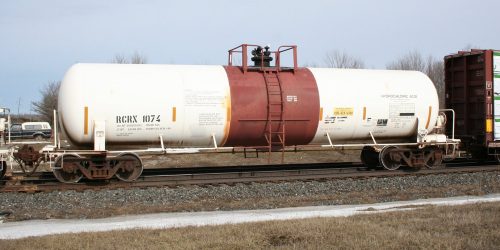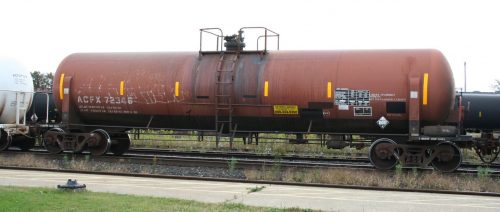Hydrochloric acid is a commonly produced industrial chemical that has applications in many chemical and industrial processes including steel making. In steel mills it is used to remove rust, scale and other surface impurities from finished steel.
While the car above was not photographed on the Algoma Central, it is representative of a common type of car in hydrochloric acid service. (Note that the Athearn 20,900 gal. RTC acid tank car is pretty much bang on for this prototype.) I did see a couple of similar SHPX cars at Hawk Junction, but didn’t get a good photo; I could also see some similar tank cars from a distance in Steelton yard from the Canyon Tour Train.
A related byproduct of using hydrochloric acid in the steelmaking process is the production of ferrous chloride as a waste product. This corrosive chemical has uses in water treatment systems, and a CN conductor friend of mine recently mentioned that he occasionally delivers a tank car of ferrous chloride from Sault Ste. Marie to the water treatment plant in downtown Toronto. Ferrous chloride (and related compounds like ferric chloride) is also shipped in tank cars of a similar size and design to hydrochloric acid.



Specification for a Hydrochloric service tank car is DOT 111A 100W5. The W5 implies a sheet applied rubber lining either 3/16″ or 1/4″ thick. Rubber linings are typically employed for the most corrosive of commodities. A small breach in the rubber lining can lead to a through wall (7/16″ thick) leak of HCL in as short as three days. Rubber linings are typically inspected every five years. In addition, most shippers perform a post loading review known as a ‘conductivity’ or continuity’ test.
Thanks Keith, that’s some neat background on acid tanks.
Note the industry white/orange paint scheme convention.
Do you know when the red band became standard on these cars? (Before 1985?)
Is it a convention? I was under the impression that the coloured band was a chemical-resistant paint to protect the centre of the car from spillage from the hatch, not to identify the contents, and the colour is just whatever colour the manufacturer makes the paint. Various cars seem to have black, white, orange/brown, red or green bands, and I’ve not noticed any pattern of contents (based on stencils or placards) vs colours. No source for any of that, though, so if you have definitive information, that overrides my observations and impressions.
Hi Chris. Not sure, exactly. My guess is probably the late 1960’s, early 1970’s, most likely initiated by Dupont. Best to check historic photos starting with DUPX.
what is the maximum load that the tank can carry?
20,900 gallons.
Nominal weight capacity is around 200K pounds (100 tons). The white and red car is stencilled for a maximum load limit of 200,200 pounds. The brown one is stencilled for 198,700 pounds.
Do you know where to acquire any HO scale tank cars with the orange band?
Athearn has a model that’s basically a direct match for the RCRX tank car in the lead photo here. Look for “20K gallon RTC acid tank”.